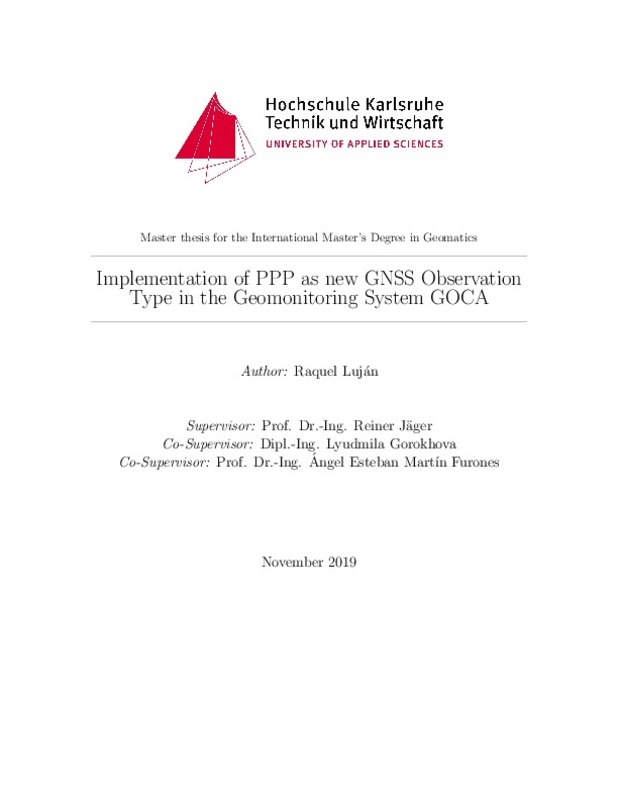JavaScript is disabled for your browser. Some features of this site may not work without it.
Buscar en RiuNet
Listar
Mi cuenta
Estadísticas
Ayuda RiuNet
Admin. UPV
Implementation of PPP as new GNSS Observation Type in the Geomonitoring System GOCA
Mostrar el registro sencillo del ítem
Ficheros en el ítem
| dc.contributor.advisor | Martín Furones, Ángel Esteban
|
es_ES |
| dc.contributor.author | Luján García Muñoz, Raquel
|
es_ES |
| dc.date.accessioned | 2020-03-27T08:26:10Z | |
| dc.date.available | 2020-03-27T08:26:10Z | |
| dc.date.created | 2020-01-07 | |
| dc.date.issued | 2020-03-27 | es_ES |
| dc.identifier.uri | http://hdl.handle.net/10251/139668 | |
| dc.description.abstract | [EN] Early detection of significant movements in both natural and artificial structures is crucial to prevent human, environmental and economic losses. For this reason, Geomonitoring in an active field. GNSS technics are also a filed in which lot of research and improvement have been made in recent years. Some studies have indicated the potential of GNSS technics in the field of Geomonitoring. The aim of this master thesis is developing a software that allows processing GNSS data with Precise Point Positioning technic in the context of the geomonitoring project GOCA. With this implementation, potential of PPP with low cost receiver (U-Blox ZED-F9P) using different products and settings is evaluated in this document. Based on a literature review, that includes the study of GOCA project and a summary of main PPP approaches, a C++ dialog-based software was design and developed, using RTKLIB and WaPPP as software engines. Besides that, two different observations were made (one 12 hours to post-processing and one real time) in order to test the developed software and evaluate the obtained results using different parameters or products. The obtained results reaffirm the potential of the PPP technique, even using low cost receiver. Even some differences between different software engines or IGS products were found, the results allow us to conclude that PPP is a technique with many advantages in the field of geomonitoring, since it avoids the use of several receivers and good accuracies are obtained. However, some aspects need further research in this context, as there is no common criterion for establishing convergence time and new methodologies and algorithms are being developed in the field of PPP processing. | es_ES |
| dc.description.abstract | [ES] La detección temprana de movimientos significativos en estructuras naturales y artificiales es crucial para prevenir pérdidas humanas, ambientales y económicas. Por esta razón, Geomonitorización es un campo activo. Las técnicas de GNSS son también un campo en el que se han realizado muchas investigaciones y mejoras en los últimos años. Algunos estudios han indicado el potencial de las técnicas GNSS en el campo de la geomonitorización. El objetivo de esta tesis de máster es desarrollar un software que permita el procesamiento de datos GNSS con la técnica de posicionamiento de punto preciso en el contexto del proyecto de geomonitorización GOCA. Con esta implementación, el potencial del PPP con el receptor de bajo coste (U-Blox ZED-F9P) usando diversos productos y configuraciones se va a evalúar en este documento. Basado en una revisión de la literatura, que incluye el estudio del proyecto GOCA y un resumen de los principales enfoques PPP, se diseñó y desarrolló un software basado en diálogos C++, utilizando RTKLIB y WaPPP como motores de software. Además, se realizaron dos observaciones diferentes (una de 12 horas para el post-procesamiento y otra en tiempo real) con el fin de probar el software desarrollado y evaluar los resultados obtenidos utilizando diferentes parámetros o productos. Los resultados obtenidos reafirman el potencial de la técnica PPP, incluso utilizando un receptor de bajo coste. Incluso habiendo encontrado algunas diferencias entre diferentes motores de software o productos IGS, los resultados nos permiten concluir que PPP es una técnica con muchas ventajas en el campo de la geomonitorización, ya que evita el uso de varios receptores y se obtienen buenas precisiones. Sin embargo, algunos aspectos necesitan más investigación en este contexto, ya que no existe un criterio común para establecer el tiempo de convergencia y se están desarrollando nuevas metodologías y algoritmos en el campo del procesamiento PPP. | es_ES |
| dc.format.extent | 173 | es_ES |
| dc.language | Inglés | es_ES |
| dc.publisher | Universitat Politècnica de València | es_ES |
| dc.rights | Reconocimiento (by) | es_ES |
| dc.subject | Geomonitoring | es_ES |
| dc.subject | GNSS | es_ES |
| dc.subject | Precise Point Positioning (PPP) | es_ES |
| dc.subject | GOCA | es_ES |
| dc.subject | Posicionamiento de punto preciso (PPP) | es_ES |
| dc.subject | Geomonitorización | es_ES |
| dc.subject | Sistema Global de Navegación por Satélite (GNSS) | es_ES |
| dc.subject.classification | INGENIERIA CARTOGRAFICA, GEODESIA Y FOTOGRAMETRIA | es_ES |
| dc.subject.other | Máster Universitario en Ingeniería Geomática y Geoinformación-Màster Universitari en Enginyeria Geomàtica i Geoinformació | es_ES |
| dc.title | Implementation of PPP as new GNSS Observation Type in the Geomonitoring System GOCA | es_ES |
| dc.type | Tesis de máster | es_ES |
| dc.rights.accessRights | Abierto | es_ES |
| dc.contributor.affiliation | Universitat Politècnica de València. Departamento de Ingeniería Cartográfica Geodesia y Fotogrametría - Departament d'Enginyeria Cartogràfica, Geodèsia i Fotogrametria | es_ES |
| dc.contributor.affiliation | Universitat Politècnica de València. Escuela Técnica Superior de Ingeniería Geodésica, Cartográfica y Topográfica - Escola Tècnica Superior d'Enginyeria Geodèsica, Cartogràfica i Topogràfica | es_ES |
| dc.description.bibliographicCitation | Luján García Muñoz, R. (2020). Implementation of PPP as new GNSS Observation Type in the Geomonitoring System GOCA. http://hdl.handle.net/10251/139668 | es_ES |
| dc.description.accrualMethod | TFGM | es_ES |
| dc.relation.pasarela | TFGM\123358 | es_ES |
Este ítem aparece en la(s) siguiente(s) colección(ones)
-
ETSIGCT - Trabajos académicos [494]
Escuela Técnica Superior de Ingeniería Geodésica, Cartográfica y Topográfica






